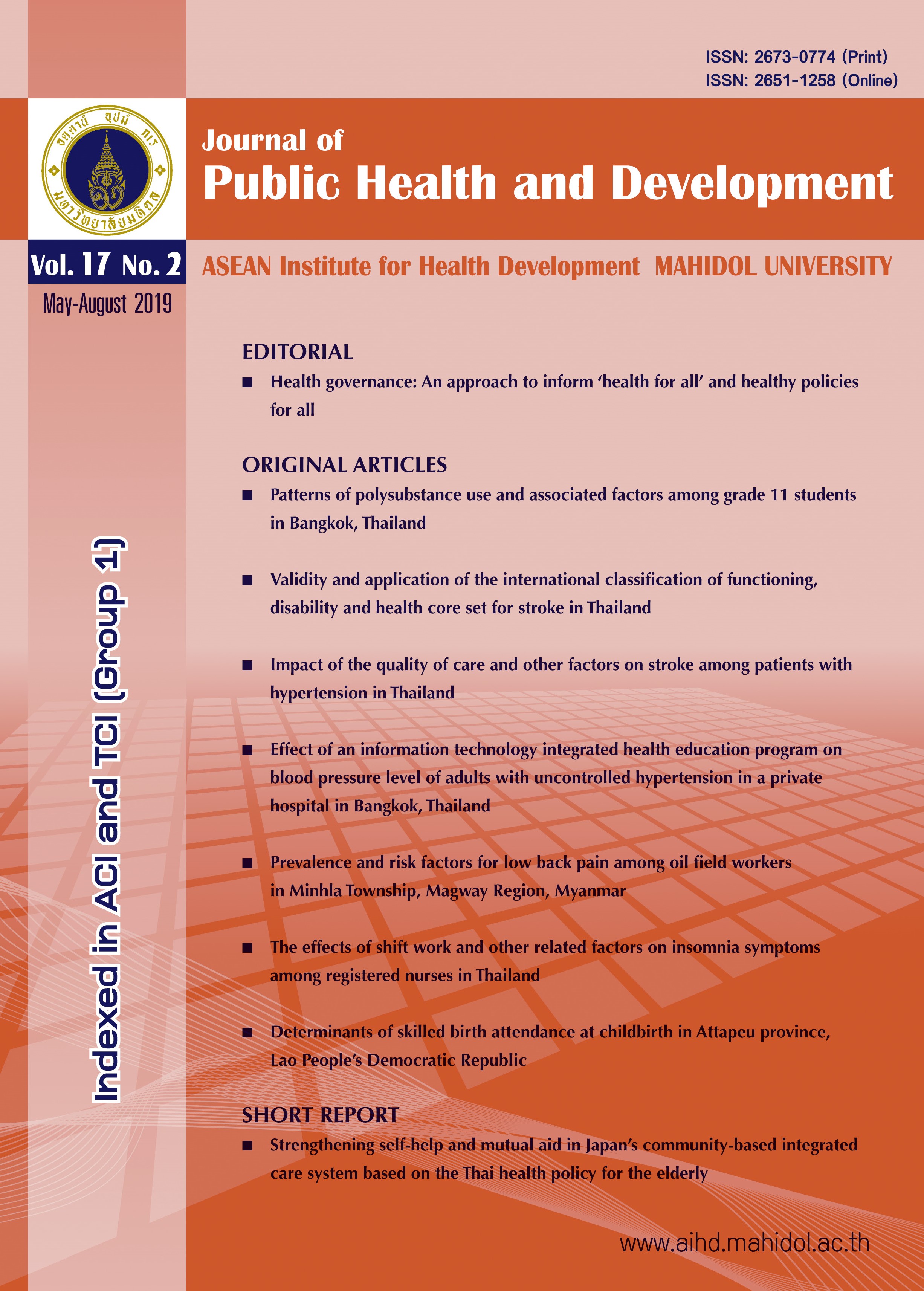The effects of shift work and other related factors on insomnia symptoms among registered nurses in Thailand
Main Article Content
Abstract
Insomnia is the most common sleep disorder and can substantially impact quality of life. The nursing profession often involves working in shifts which may lead to increased risk of insomnia symptoms. Understanding the factors associated with insomnia in nurses is important for improving the sleep health and quality of working life of registered nurses in Thailand. The baseline data of the Thai Nurse Cohort Study which included the responses of 18,189 registered nurses collected in 2009 was employed. The authors considered the three insomnia symptoms: Difficulty Initiating Sleep, Difficulty Maintaining Sleep, and Early Morning Awakening. Workplace burden variables and other potentially important factors were also collected. Multiple logistic regression using mixed effect models was applied for the data analysis.
The response rate of this sudy was 58.6%. Most participants were females (96.7%) with mean age of 43.4 years (s.d.= 9.7) and worked predominantly in the day shift (71.3%). Almost one-quarter (24.6%; 95% CI = 23.3 - 25.9) reported experiencing at least one insomnia symptoms. The prevalence of difficulty initiating sleep, difficulty maintaining sleep and early morning awakening were 5.2% (95% CI = 3.7 - 6.7), 8.0% (95% CI = 6.5 - 9.4) and 6.5% (95% CI = 5.0 - 8.0), respectively. Evening and Night shift were associated with a higher risk of both difficulty initiating sleep (Adj. ORevening = 2.11, 95% CI = 1.45 - 3.07; Adj. ORnight = 1.72, 95% CI = 1.01 - 2.94, respectively) and early morning awakening (Adj. ORevening = 1.46, 95% CI = 1.01 - 2.11and Adj. ORnight = 0.41, 95% CI = 0.18 - 0.95, respectively). No workplace burden factors were associated with difficulty maintaining sleep. Perceived mental health and perceived pain were highly associated with all three insomnia symptoms.
The authors demonstrate shift work substantially impacts insomnia symptoms among Thai nurses. Policy-making for nursing personnel recruitment and retention should include the optimization of shift work
schedule allocation to promote good sleep health.
Article Details
References
2. Avidan AY. Normal Sleep. In: Kryger M, editor. Atlas of Clinical Sleep Medicine. Philadelphia, PA: Elsevier; 2010. p. 61-8.
3. Chen DR, Kuan PY. Gender, sleep problems, and obesity in Taiwan: a propensity-score-matching approach. Women & Health2015;55(2):19-33.
4. Stranges S, Tigbe W, Gomez-Olive FX, et al. Sleep problems: an emerging global epidemic? Findings from the INDEPTH WHO-SAGE study among more than 40,000 older adults from 8 countries across Africa and Asia. Sleep2012;35(8):1173-81.
5. Paparrigopoulos T, Tzavara C, Theleritis C, et al. Insomnia and its correlates in a representative sample of the Greek population. BMC public health2010;10(531):1-7.
6. Yazdi Z, Sadeghniiat-Haghighi K, Loukzadeh Z, et al. Prevalence of Sleep Disorders and Their Impacts on Occupational Performance: A Comparison between Shift Workers and Nonshift Workers. Sleep Disorders 2014;2014(870320):5.
7. Ohayon MM, Reynolds CF. Epidemiological and clinical relevance of insomnia diagnosis algorithms according to the DSM-IV and the International Classification of Sleep Disorders (ICSD). Sleep Medicine 2009;10(9):952-60.
8. Lian Y, Xiao J, Liu Y, et al. Associations between insomnia, sleep duration and poor work ability. Journal of Psychosomatic Research 2015;78(1):45-51.
9. Spiegelhalder K, Scholtes C, Riemann D. The association between insomnia and cardiovascular diseases. Nature and Science of Sleep 2010;2:71-8.
10. Kato T. Insomnia symptoms, depressive symptoms, and suicide ideation in Japanese white-collar employees. International journal of behavioral medicine 2014;21(3):506-10.
11. Parthasarathy S, Vasquez MM, Halonen M, et al. Persistent insomnia is associated with mortality risk. The American journal of medicine 2015;128:268-75.
12. Flo E, Pallesen S, Magerøy N, et al. Shift Work Disorder in Nurses – Assessment, Prevalence and Related Health Problems. PloS one 2012;7(4):e33981.
13. Lo WY, Chiou ST, Huang N, Chien LY. Long work hours and chronic insomnia are associated with needlestick and sharps injuries among hospital nurses in Taiwan: A national survey. International journal of nursing studies 2016;64:130-6.
14. Yazdi Z, Sadeghniiat-Haghighi K, Javadi AR, et al. Sleep quality and insomnia in nurses with different circadian chronotypes: morningness and eveningness orientation. Work2014;47(4):561-7.
15. Portela LF, Luna CK, Rotenberg L, et al. Job Strain and Self-Reported Insomnia Symptoms among Nurses: What about the Influence of Emotional Demands and Social Support? BioMed Research International 2015;2015(820610):1-8.
16. Kasatpibal N, Whitney JD, Katechanok S, et al. Prevalence and risk factors of needlestick injuries, sharps injuries, and blood and body fluid exposures among operating room nurses in Thailand. American journal of infection control 2016;44(1):85-90.
17. Asaoka S, Aritake S, Komada Y, et al. Factors associated with shift work disorder in nurses working with rapid-rotation schedules in Japan: the nurses' sleep health project. Chronobiology international 2013;30(4):628-36.
18. Oyane NM, Pallesen S, Moen BE, et al. Associations between night work and anxiety, depression, insomnia, sleepiness and fatigue in a sample of Norwegian nurses. PloS one 2013;8(8):e70228.
19. Udomratn P. Prevalence of insomnia in the Thai population. ASEAN Journal of Psychiatry2008;9(1):42-7.
20. Admi H, Tzischinsky O, Epstein R, et al.Shift work in nursing: is it really a risk factor for nurses' health and patients' safety? Nursing economic 2008;26(4):250-7.
21. Kim BH, Lee HE. The association between working hours and sleep disturbances according to occupation and gender. Chronobiology international 2015;32(8):1109-14.
22. Sadeghniiat-Haghighi K, Yazdi Z, Kazmifar AM. Sleep quality in long haul truck drivers: A study on Iranian national data. Chinese Journal of Traumatology 2016;19(4):225-8.


